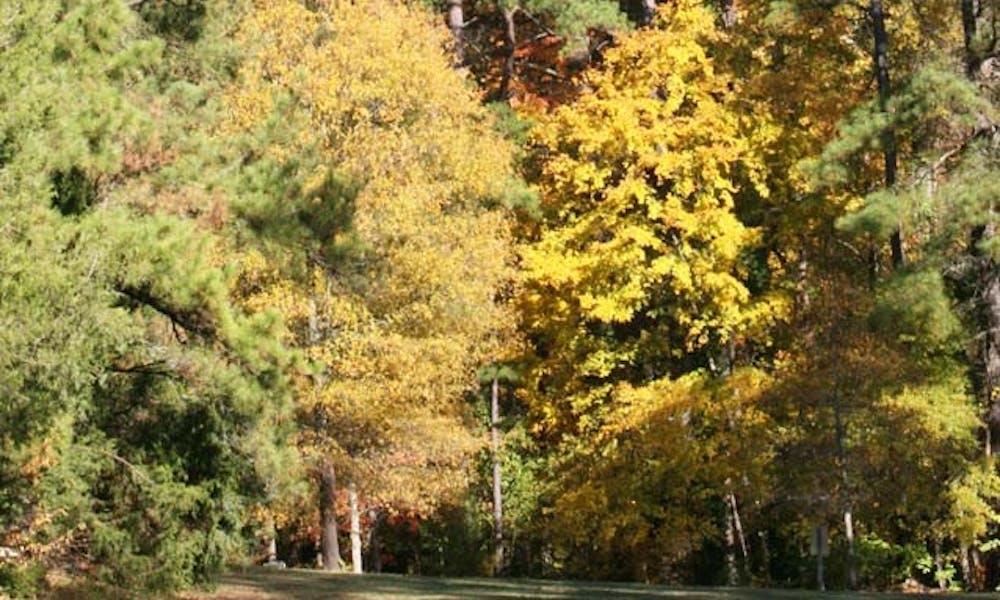The Duke Forest was renewed as an asset in the University’s mission toward sustainability early last month.
The Forest Stewardship Council reviewed the Duke Forest in a sustainability assessment Oct. 6 and Oct. 7 as part of a recertification that occurs every five years. The Duke Forest was evaluated according to guidelines of the FSC—a non-governmental organization that promotes the responsible forest management worldwide—focused on the social, environmental and economic effects of forest management.
“The management of our forest is being done to an internationally recognized set of standards as being sustainable from an environmental, social and economic perspective,” Duke Forest Resource Manager Judson Edeburn said. “It really follows Duke’s commitment to sustainability in that Duke is also managing its forest to a high set of sustainability standards.”
This was the first time that the Duke Forest underwent the assessment since adopting a new set of FSC standards October 2010. These standards are meant to increase transparency, monitor timber generation practices and maintain the forest’s sustainable management.
“We had to have in place a written monitoring program for water quality, invasive species [and] forest health,” Edeburn added. “We needed to have a written procedure and a written way to document that we are monitoring some things that take place in the forest.”
FSC representatives could not be reached for comment.
With this policy, third party viewers will know that forest management complies with FSC standards based on written documents and records, Edeburn added,
Duke also underwent an evaluation for the FSC chain of custody certification during the October audit. The chain of custody certification acts as a trademark that indicates to consumers that the timber product they are purchasing has come from a responsibly managed forest.
This certification ensures that only those who are FSC certified handle wood from the time it is cut to the end product, Duke Forest Program Director Sara Childs said. The chain of custody stamp is given at the same time as the FSC certification.
“The more there is a demand of FSC product at the point of consumer, the more likelihood we will have players in the market that will become FSC certified because they will see the economic return on it,” Childs said.
The reassessment of the certification reflects the University’s efforts towards sustainability, and the FSC standards relate to both the forest and its effect on other members of the community, Edeburn said.
“It encourages us to consider the impact on our stakeholders—we have many stakeholders because we are a teaching and research lab—but we also allow for the recreational user, and we are neighbors to neighborhoods of private land owners,” Childs added.
Those who manage the forest need to be able to consider the opinions and comments of the stakeholders, she said, noting that being able to respond and act for the benefit of the entire community is a major part of certification.
Although the FSC does not have a direct policy regarding climate change, the issue is taken into consideration when evaluating forests for certification.
“One of the criteria does involve monitoring forest conditions that could be contributed to climate change, like are we having more or less impacts on insects; are we seeing more or less invasive species; are we seeing shifts in plant species communities?” Edeburn said.
Because so many factors—including climate change—have impacts on forest life, it is necessary to examine those effects against FSC criteria of forest conditions, Childs said. Climate change, for example, is a factor the FSC considers in regulating the use of forests for timber.
“In general the FSC standard by default encourages carbon sequestration,” she noted.
Carbon sequestration—the process of removing carbon from the atmosphere—is also promoted through the growth of forests. This entails growing a younger forest for a long time and then cutting the wood for timber. This process locks the carbon into an end product, so it never enters the atmosphere, Childs said. In addition, FSC does not allow for mass clear cutting of land, further encouraging carbon sequestration.
Forestry Technician Michael Burke noted the benefits of FSC certification.
“It is good to get a confirmation that the [sustainability] practices that you are performing are good,” Burke said.
Get The Chronicle straight to your inbox
Signup for our weekly newsletter. Cancel at any time.

